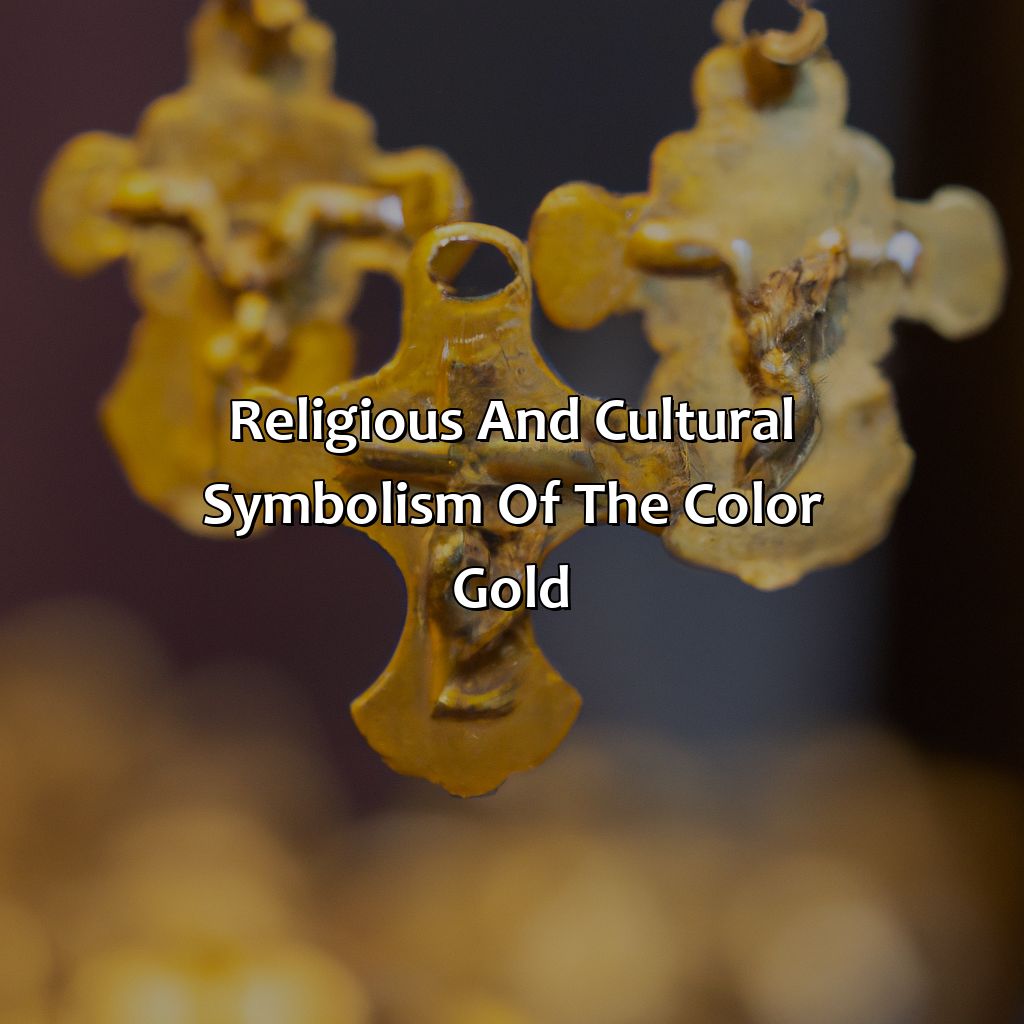Key Takeaway:
- The color gold holds significant meaning and symbolism across cultures and religions, often associated with wealth, prosperity, and success.
- Gold has been used in religious ceremonies and art, with Christianity, Buddhism, and Hinduism all having their own unique interpretations of its significance.
- Additionally, gold has been found to have a positive impact on mental and emotional well-being, with color therapy utilizing its vibrant energy for healing and mood enhancement. Gold is also a popular element in fashion, design, and architecture, representing luxury and elegance.
Understanding the Significance of the Color Gold

Photo Credits: colorscombo.com by Kevin Hall
The Significance of Gold: Understanding Its Symbolism
Gold has always been a color of significance throughout human history. It represents wealth, prosperity, and luxury. This majestic color has been associated with royalty, high status, and achievement. From ancient times to the present day, the color gold has never lost its charm and its symbolism has remained strong.
The Meaning and Symbolism of Gold
Gold represents the sun and is often associated with the divine. In various cultures, it denotes immortality, enlightenment, and wisdom. Gold is also linked with success, achievement, and victory. In some cases, it conveys the message of purity and clarity. Overall, gold is a symbol of positivity and optimism.
The Unique Details of Gold Symbolism
Apart from its general symbolism, gold has unique meanings in different cultures. In Chinese culture, gold is linked with good fortune and prosperity. In Indian culture, it is associated with purification and renunciation. In Islamic culture, the color gold is used in religious ceremonies and represents wealth and abundance.
A True Story of Gold Symbolism
In the ancient Aztec civilization, gold held a significant place in their religious ceremonies. It was believed that the sun god required gold as an offering to keep the sun shining. The Aztecs believed that if they did not offer enough gold to the sun god, he would stop shining his light on the world.
Religious and Cultural Symbolism of the Color Gold

Photo Credits: colorscombo.com by Dylan Taylor
Unlock the hidden religious and cultural values of the color gold in Christianity, Buddhism, and Hinduism. Dive into the sub-sections:
- The Color Gold in Christianity
- The Color Gold in Buddhism
- The Color Gold in Hinduism
Uncover how gold is used in religious artwork, golden statues, deities, and rituals, and what it symbolizes in each tradition.
The Color Gold in Christianity
The significance of gold in Christianity is deeply rooted in the Bible. It symbolizes divinity, glory, and purity. The use of gold in religious art signifies that which is holy and sacred.
In Christian art, gold is often used to depict heaven and the divine light of God. It represents faith, hope and eternal life that Christians believe they will receive after death. Gold also symbolizes charity, love, and kindness which are the central teachings of Christianity.
Gold plays a significant role in Christian liturgical attire such as priestly robes, chalices, altar decorations and other items for church services.
Christians believe that Jesus’ offering of gold by the wise men was symbolic of His majesty as King of kings and Lord of lords. Gold is also mentioned numerous times in the Bible where it is depicted as a precious metal; it was also used as an offering for cleansing from sin.
Gold remains highly desirable in Christianity not only because it’s a symbol of wealth but because it holds spiritual significance. Its use reminds devout followers to acknowledge aspects like faith, prestige and highlights their significance in various facets of religious worship.
Even Buddha knew the value of bling with those golden statues.
The Color Gold in Buddhism
Buddhism’s Sacred Gold: Insights into the Color’s Significance and Use
Golden statues are a vital part of Buddhism, representing enlightenment and divinity. Gold’s luster conveys ancient wisdom and longevity related to Buddhism’s religious traditions. In an enduring ritual, Buddhist temples in Asia are adorned with golden Buddha statues, symbolizing lasting spiritual value.
The use of the color enhances Buddhists’ well-being through attracting positive energies, imparting serenity and helping overcome mental obstacles. In meditative practices, gold helps practitioners attain calmness, clarity and focus.
Unique details about Buddhism’s use of gold include its association with sun rays which depict enlightenment and the passage from life to death. Additionally, The Golden Temple in Amritsar is a prominent symbol dedicated to Sikhism.
Don’t miss out on experiencing Buddhism’s sacred gold through golden statue rituals when visiting oriental temples. Even the gods in Hinduism can’t resist the allure of gold in their ceremonies and adornments.
The Color Gold in Hinduism
The golden color has significant importance in Hinduism, where it symbolizes prosperity, knowledge, and purity. Deities in Hindu scriptures are often portrayed wearing golden crowns and jewelry. Gold is used in various ceremonies, such as weddings and festivals, signifying wealth and good fortune.
In Hindu culture, the significance of gold is also related to the belief that it came from the heavens. The story goes that when Lord Indra defeated the mighty demon Vritra and released the waters trapped by him, a river of gold flowed out of his belly button. Therefore, gold is considered divine and auspicious.
Furthermore, gold is not only limited to religious rituals but also crafts like textiles and artwork. In traditional Indian attire like sarees or lehengas, golden embroidery or borders are often incorporated for an elegant look.
Pro Tip: Gold can be used as a subtle decor element in your house by adding metallic accents like frames or candle holders to achieve a luxurious vibe.
Gold may not solve all your psychological problems, but it sure is a shiny distraction.
Psychological Impact of the Color Gold

Photo Credits: colorscombo.com by Kevin Rodriguez
To understand the psychological effects of gold, we need to look into its emotional impact. Gold can have a good influence on moods and emotions. It is often used in color therapy because of its possible healing and energizing power.
Impact of Gold on Emotional and Mental Well-Being
Gold is a color that can have a significant impact on emotional and mental well-being. Its positive effects include mood enhancement and an increased sense of self-confidence. In many cultures, gold is associated with wealth and success, which can also contribute to a person’s emotional state.
In ancient Chinese medicine, gold was used to treat various illnesses and promote healing. The therapeutic properties of the color were thought to increase circulation, boost immunity and relax the mind. Gold is still used in color therapy for its mood-enhancing effects.
Gold is often seen as a prestigious color that carries associations with royalty, luxury, and exclusivity. The use of gold in clothing and accessories can make one feel special, increasing feelings of confidence, power, and wealth.
One true history of the impact of gold on emotional well-being comes from ancient Egypt. The pharaohs believed that using gold had both physical and spiritual benefits. They would wear elaborate headdresses made of pure gold to propel their spirits towards the afterlife. Additionally, it was believed that wearing gold jewelry could have positive effects on emotions, particularly by alleviating depression.
Gold is a versatile and powerful color with deep cultural significance around the world. Understanding its influence on emotional well-being can help one harness its psychological benefits to induce positive moods and improve overall mental health.
Turn your aura into gold with the healing touch of color therapy.
Use of Gold in Color Therapy
Utilizing the vibrational energy of colors in therapy is a common practice, and gold has shown beneficial effects in healing. When employed in color therapy, gold promotes mental strength, confidence, and self-esteem. This use of the metallic shade helps to dissolve negativity and facilitate wisdom through reflection.
Additionally, gold has shown to have anti-inflammatory properties making it helpful in easing physical pain. By using the warm tones of this shining color, patients are often comforted and lifted from depression.
Gold can be utilized together with other colors for enhanced benefits as a complementary color. In such instances, it may have synergistic effects that are greater than its individual effect.
Book a color therapy session today to experience firsthand the power of gold’s transformative abilities in your life. Who needs diamonds when you can have gold in fashion and interior design?
Gold in Fashion and Interior Design

Photo Credits: colorscombo.com by Russell White
Gold’s significance in fashion and interior design is remarkable. Boost your wardrobe, accessories and home decor with this versatile color! Using gold in clothing and accessories keeps you in style and luxury. When it comes to home decor and architecture, gold enhances the design elements of your living space.
Use of Gold in Clothing and Accessories
Gold is a color that has continued to shine over the years in clothing and accessories. Trends in fashion have seen the use of gold in various clothing and accessory designs as a symbol for luxury and elegance.
Many designers incorporate gold into their clothing designs using embroidery, prints, or gold-colored fabrics. For instance, evening gowns and formal suits may feature embroidery or print designs with gold threads or colors to add sophistication. Accessories such as jewelry, belts, bags, shoes, and hats often use gold elements to create an opulent look.
The history of using gold in fashion dates back to ancient times when it was viewed as a sign of wealth and status. The Egyptians were among the first civilizations who extensively used gold in their clothing and accessories. They incorporated gold into their garments by weaving golden threads together with colored fabrics.
In modern-day fashion trends, gold continues to be a widely used color that signifies elegance, glamour, sophistication, success, and luxury. Designers create designs that embody these qualities using materials such as sequins, lace motifs or just adding small metallic details.
Also read: Psychological Effects of Colors on Humans
Overall, the use of gold in clothing and accessories remains significant due to its prestigious associations; it adds value to any piece or garment while adding richness at the same time.
Add a touch of opulence to your home with the versatile and powerful color gold, elevating your interior design and architecture game to a whole new level.
Gold in Home Decor and Architecture
Incorporating gold as an interior design and architectural element of design is a luxurious and timeless choice. Its reflective properties create a warm and inviting ambiance in any space, from traditional to modern. Gold accents can be incorporated through fixtures, hardware, lighting, or paint color to elevate the overall aesthetic of the room. Gold leafing on walls or ceilings can add texture and depth to a space that other finishes cannot replicate. The opulence of gold makes it a popular choice for interior designers and architects alike. Don’t miss out on the opportunity to incorporate this powerful color into your home decor or architecture projects.
Five Facts About What the Color Gold Means:
- ✅ Gold is often associated with wealth, prosperity, and abundance. (Source: ColorPsychology.org)
- ✅ The color gold is also linked to success, achievement, and victory. (Source: BournCreative.com)
- ✅ In some cultures, gold is a symbol of immortality, eternity, and spiritual enlightenment. (Source: Sensationalcolor.com)
- ✅ Gold is used in many logos and branding because it is eye-catching and associated with quality. (Source: Designyourway.net)
- ✅ The use of gold in interior design is believed to create a sense of luxury, sophistication, and elegance. (Source: Freshome.com)
FAQs about What Does The Color Gold Mean
What does the color gold mean?
Gold is often associated with wealth, prosperity, and success. It is a symbol of luxury and elegance. In many cultures, gold is also a symbol of immortality and divinity. In addition, gold is often used to represent the sun and its life-giving properties.
Does the meaning of gold vary in different cultures?
Yes, the meaning of gold can vary in different cultures. For example, in some Eastern cultures, gold is associated with love and marriage, while in Western cultures, it is more commonly associated with wealth and power.
What are some common uses of gold in art and design?
Gold is a popular color in the world of art and design, often used to add a touch of luxury and elegance to a range of products. Some common uses of gold include jewelry, clothing, home decor, and packaging for high-end products.
What emotions are commonly associated with the color gold?
The color gold is often associated with feelings of warmth, happiness, and optimism. It is also often associated with feelings of wealth, power, and success. Gold can be a very energizing and uplifting color.
What is the symbolic significance of the color gold?
The symbolic significance of the color gold can vary depending on the context. It is often associated with the sun, which is a symbol of life, vitality, and energy. In addition, gold is often seen as a symbol of power, wealth, and success. It can also represent purity and perfection.
What is the psychology behind the color gold?
The psychology behind the color gold is related to its association with wealth, power, and success. Gold is often seen as a symbol of achievement and prestige, and it can be a very motivating color. It is also associated with positivity and happiness, as well as creativity and innovation.





